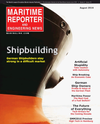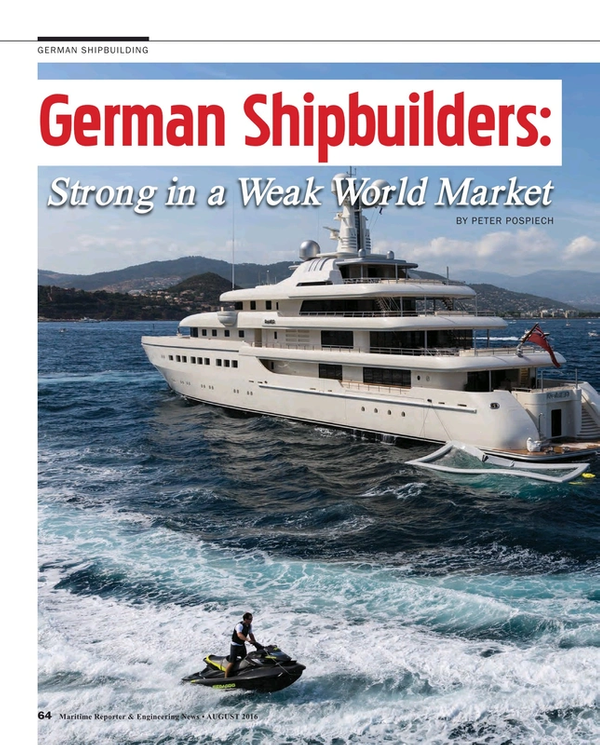
German Shipbuilders Strong in a Weak World Market
By Peter Pospiech
VSM: Collapse in demand dampens expectations for the current year
The global shipbuilding industry continued its downturn in 2015 with the number of new orders halved compared to 2013 level. The year 2016 is shaping up to be even worse.
The “Big Three” shipbuilding nations China, Korea and Japan are major customers to the world leading maritime equipment and system producers from Germany. The fact that the domestic supply chain has been generating more than half of its sales within Europe will come in as an important stabilizing factor to weather the current storm: according to Clarksons Research, more than $7 billion worth of orders for newbuilding projects went to Europe this year, a world market share of 63 percent. Furthermore, the current low ordering activity in Asian comprises mainly shipowners with fixed employment for their newbuilding projects. These customers tend to pay more attention to quality equipment, which is why the success rate of German equipment makers has significantly increased for the few remaining projects.
Nevertheless, the total demand in numbers remains low and causes major challenges also in the German maritime community.
German shipyards bucked the global trend by nearly doubling their order intake reaching nearly €5 billion in 2015 compared to 2013. A similar order of magnitude was recorded also for 2016 to date.
“This great success of the maritime sector of the German industry has its origins in our customers’ exceptionally high expectations. The high degree of complexity of the products manufactured here requires large numbers of highly specialised experts. Hundreds of companies, all of them extremely reliable, must be coordinated perfectly to work towards a common goal and jointly ensure the success of the given project. These kinds of structures have grown in Germany over decades and cannot easily be replicated in other countries,” said VSM President Harald Fassmer, CEO of the shipyard Fassmer Werft GmbH, describing the situation during the press conference held on occasion of the annual VSM General assembly meeting.
“But there is no time to be complacent. We must relentlessly continue in our efforts to further improve products and processes. We have to seize every opportunity to jointly safeguard Germany as a stronghold of the maritime industry. It is therefore essential that we all come together as one industry and one community,” said Fassmer in a compelling appeal.
Even if the German shipyards, based on their specialization, are not afraid of the competition – a concerned look went to Asia: “China will build vessels for their own required cruise market within the next five years”, stated VSM-Chief Fassmer, “Until then they will not be better than German shipyards.”
Inspired by the same vision, VSM has launched and is driving new initiatives, including, in particular the German Maritime Export Initiative (GeMaX) as well as efforts to fos-ter innovation by establishing a new Maritime Research Coordination Center (Deutsches Maritimes Zentrum, DMZ).
“These activities demonstrate that the industry is doing its homework,” adds VSM General Manager Reinhard Lüken, “but we also need back up by policy makers. The idea of launching a maritime agenda for Germany is therefore a great opportunity.”
Policy initiatives include efforts to foster LNG as maritime fuel, an active trade policy to improve market access and fight against market distortions as well as support for the naval defense industry base.
The German Shipbuilding Industry
Based upon the concentration of the German shipyards in innovative and promising markets – such as the passenger vessel and yacht shipbuilding – the order situation in 2015 was relatively good. Around 100 percent of the order income, deliveries and backlog with seagoing vessels have been dedicated to export, and many shipyards have built a comfortable order cushion for the coming years. But between the different companies are significant differences.
Twelve newbuilds were ordered in German shipyards in 2015 – with half of it generated in the last quarter alone – valued at approximately $5.4 billion. Incoming orders with regard to tonnage increased 25% compared to 2014 to 750,000 CGT (Compensated Gross Tonnage), but the number of deliveries (16 vessels) was lower than in 2014. The tonnage (435,000 CGT) was also lower than one year before, but higher than the total tonnage in 2013. The value of the deliveries in 2015 was in total around $2.5 billion – also somewhat lower than in 2014. In addition, three platforms for the offshore wind industry, valued at $330 million, have been delivered.
By the end of December 2015 43 vessels, valued at about $14.4 billion, (the highest contract value since 2009) were on the order books of German shipyards. The tonnage with 2 million CGT is higher than in 2014. Two additional orders for new buildings of plants and platforms for the offshore wind industry increased the total order backlog of the shipyards to $14.8 billion.
According to the German Federal Statistical Office, sales at the German shipyards (taking into account shipyards with a minimum of 50 employees from all market segments, including naval ship building, repair/modification, as well as boats, yacht and inland waterway shipbuilding) were down 20% to $5.6 billion (compared to $7.1 billion in 2014). At the same time, the number of employees increased 3% to 18,042.
During the first four month of 2016 orders received the national yards totaled nine vessels valued at $1.4 billion. This does not include the orders about 10 vessels from the Malaysian Genting Group, because this order, valued $3.8 billion, was placed in May 2016.
(As published in the August 2016 edition of Maritime Reporter & Engineering News)
Read German Shipbuilders Strong in a Weak World Market in Pdf, Flash or Html5 edition of August 2016 Maritime Reporter
Other stories from August 2016 issue
Content
- Artificial Stupidity page: 14
- The Economics of Ship Breaking & Scrapping page: 18
- The Past, Present & Future of the ‘Noon Report’ page: 22
- The European Network of National Maritime Clusters page: 24
- Growing Up Metric page: 32
- Keeping Hulls Clean One Barnacle at a Time page: 46
- Astican & Astander Continue to Invest page: 60
- German Shipbuilders Strong in a Weak World Market page: 64
- DPS & Closing the Door on Unnecessary Risk page: 74
- Lifetime Assessment for Deepwater Moorings page: 78
- Green Ships & Compliance page: 80
- Better Turbocharger Performance, Proven Tech page: 94
- Five Minutes with Paul Switzer page: 106


